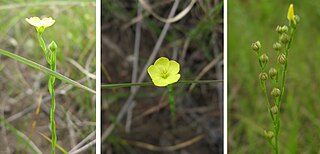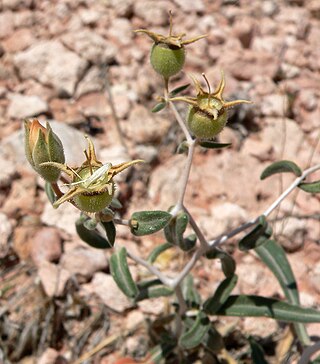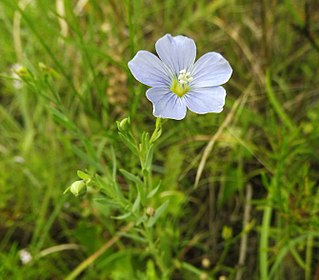
Flax, also known as common flax or linseed, is a flowering plant, Linum usitatissimum, in the family Linaceae. It is cultivated as a food and fiber crop in regions of the world with temperate climates. In 2022, France produced 75% of the world's supply of flax.

Linum lewisii is a perennial plant in the family Linaceae, native to western North America.

Linum perenne, the perennial flax, blue flax or lint, is a flowering plant in the family Linaceae, native to Europe, primarily in the Alps and locally in England. It has been introduced into North America, where it can be found on mountain ridges, wooded areas, and in sandy plain habitats of the sagebrush steppe, growing near sagebrush and rabbitbrush (Chrysothamnus).

Park Key is an uninhabited island in the lower Florida Keys about 14 miles (23 km) east of Key West. It is 1500 meters long, and between 75 and 260 meters wide. It measures 70 acres in area.

Hesperolinon congestum, or Marin dwarf flax, is an annual herb, which is known to occur only in San Mateo, San Francisco and Marin County, California, United States. This plant occurs chiefly on serpentine soils, especially in dry native bunch grasses, chaparral or other grasslands at elevations less than 200 meters. The flowers are congested at the tips of the dichotomously branching stems. H. congestum is in flower between April and July. The outlook for this plant depends on survival of only about twenty small colonies, most of which are not actively managed for protection, even though the species is federally and state-listed as threatened. This species is also less commonly known as Marin western flax.

Lithospermum incisum is a species of flowering plant in the borage family known by several common names, including fringed puccoon, narrowleaf stoneseed, fringed gromwell, narrowleaf puccoon, and plains stoneseed. It is native to much of central Canada and the United States, where it is known from many types of habitat, but particularly piñon-juniper woodland. It is a hairy perennial herb growing from a narrow brown to black taproot and woody caudex. It produces a cluster of stems up to about 30 centimeters long. The stems are lined with narrow, pointed leaves up to 6 centimeters long. The slender, trumpet-shaped flowers are pale to bright yellow or gold, and may approach 4 centimeters long. The corolla face is 1 to 2 centimeters wide, its lobes sometimes ruffled. The smaller cleistogamous (closed) flowers are the main producers of seed.
Hesperolinon drymarioides is a rare species of flowering plant in the flax family known by the common names drymary dwarf flax and drymaria-like western flax; it is named for its resemblance to genus Drymaria. It is endemic to California, where it grows in the central inland North Coast Range. Most of the few known occurrences have been noted in Lake County. It is a plant of serpentine soils in chaparral and woodland ecosystems. This is a small annual herb growing a thin branching brown stem low to the ground or erect to about 20 centimeters in height. Leaves appear in whorls of four on the lower part of the stem and are dark reddish green with plentiful glandular hairs. Its flowers have light pink-veined white petals in a corolla about a centimeter across. Protruding stamens hold large yellow or purplish-white anthers.
Tetrapteron palmeri is a species of evening primrose known by the common name Palmer evening primrose. It is native to the western United States from California to Idaho, where it grows in several habitat types, including desert and sagebrush. It is a roughly hairy annual herb growing in a low patch on the ground, generally with no stem. The leaves are widely lance-shaped and up to about 5 centimeters long, with a few small teeth along the edges. The nodding inflorescence produces flowers with yellow petals only 2 or 3 millimeters long each and a noticeable bulbous stigma tip which may be up to a centimeter wide. The fruit is a leathery capsule around half a centimeter long with small wings near the tip.

Euptoieta claudia, the variegated fritillary, is a North and South American butterfly in the family Nymphalidae. Even though the variegated fritillary has some very different characteristics from the Speyeria fritillaries, it is still closely related to them. Some of the differences are: variegated fritillaries have two or three broods per year vs. one per year in Speyeria; they are nomadic vs. sedentary; and they use a wide range of host plants vs. just violets. And because of their use of passionflowers as a host plant, variegated fritillaries also have taxonomic links to the heliconians. Their flight is low and swift, but even when resting or nectaring, this species is extremely difficult to approach, and, because of this, its genus name was taken from the Greek word euptoietos meaning "easily scared".

Linum grandiflorum is a species of flax known by several common names, including flowering flax, red flax, scarlet flax, and crimson flax. It is native to Algeria and Tunisia, but it is known elsewhere in Northern Africa, Southern Europe and in several locations in North America as an introduced species. It is an annual herb producing an erect, branching stem lined with waxy, lance-shaped leaves 1 to 2 centimeters long. The inflorescence bears flowers on pedicels several centimeters long. The flower has 5 red petals each up to 3 centimeters long and stamens tipped with anthers bearing light blue pollen. It can on occasion be found as a casual well outside its normal established range; records from the British Isles, for example, are reasonably frequent but, grown as an annual, it rarely persists for more than one season.

Linum medium, common name stiff yellow flax, is a species of Linum (flax) native to eastern North America. It is found as far west as Texas and Wisconsin, east to the Atlantic Ocean, north to Ontario and Maine, and south to southern Florida. It is also found in The Bahamas.

Xanthisma gracile is a species of annual flowering plant in the family Asteraceae known by the common names slender goldenweed and annual bristleweed.

Mentzelia polita is a species of flowering plant in the family Loasaceae known by the common name polished blazingstar. It is native to the southwestern United States, where it grows in desert mountains, washes, and other dry habitat.

Triteleia dudleyi is a species of flowering plant known by the common name Dudley's triteleia. It is endemic to California, where it is known from sections of the High Sierra Nevada and the Transverse Ranges. It is a plant of subalpine climates, growing in mountain forests. It is a perennial herb growing from a corm. It produces two or three basal leaves up to 30 centimeters long by one wide. The inflorescence arises on an erect stem up to 30 or 35 centimeters tall and bears an umbel-like cluster of many flowers. Each flower is a funnel-shaped yellow bloom that dries purple. The flower has six lobes measuring up to 1.2 centimeters long. There are six stamens with lavender anthers.
Verbena menthifolia is a species of verbena known by the common name mint-leaved vervain or mint vervain. It is native to the southwestern United States and northern Mexico, where it occurs in many types of open, dry habitat such as desert scrub. This perennial herb produces one or more rough-haired, erect stems up to about 75 centimeters in maximum height. The hairy leaves are a few centimeters long and are divided near the base into a few narrow lobes which have serrated edges. The inflorescence is made up of one to three narrow, erect spikes of flowers up to 30 centimeters long. The flowers are spaced, not densely packed on the slender spike. Each flower has a small purple corolla 2 or 3 millimeters wide.

Linum narbonense, the perennial flax or blue flax, is a flowering plant in the family Linaceae, native to Europe and similar in appearance to Linum perenne.

Linum flavum, the golden flax or yellow flax, is a species of flowering plant in the family Linaceae, native to central and southern Europe. It is an erect, woody perennial growing to 30 cm (12 in) tall by 20 cm (8 in) broad, with dark green, semi-evergreen leaves, and terminal clusters of bright yellow, five-petalled flowers in spring. The Latin flavum means "pure yellow".

Linum pratense, commonly called meadow flax, is a species of flowering plant in the flax family (Linaceae). It is native to the United States, where it is found in the south-central and southwestern regions of the country. Its natural habitat is in dry, open prairies over calcareous or sandy soil. It can be found in both intact and disturbed communities.

Linum strictum, commonly known as rigid flax, upright flax, and upright yellow flax, is a species of flax with a rigid stem, from whence it derives its taxonomic name, growing to a height of 10–45 cm. The plant is endemic to the Mediterranean region, as well as native to Sudan, Ethiopia, Eritrea, Croatia, Bosnia and Herzegovina, Montenegro, Crimea, Albania, Portugal, Jordan, Iraq, Iran, Madeira, the Canary Islands, the Transcaucasus, Saudi Arabia (Asir), Bahrain, Qatar, Pakistan, and northwest India. It features highly in classical Hebrew and Greek literature, owing principally to its cultivation for its plant fiber, linen, but also for its edible seeds and culinary foliage.

Linum sulcatum, common names yellow flax, grooved yellow flax, grooved flax, and yellow wild flax is a plant native to the United States and Canada.


















